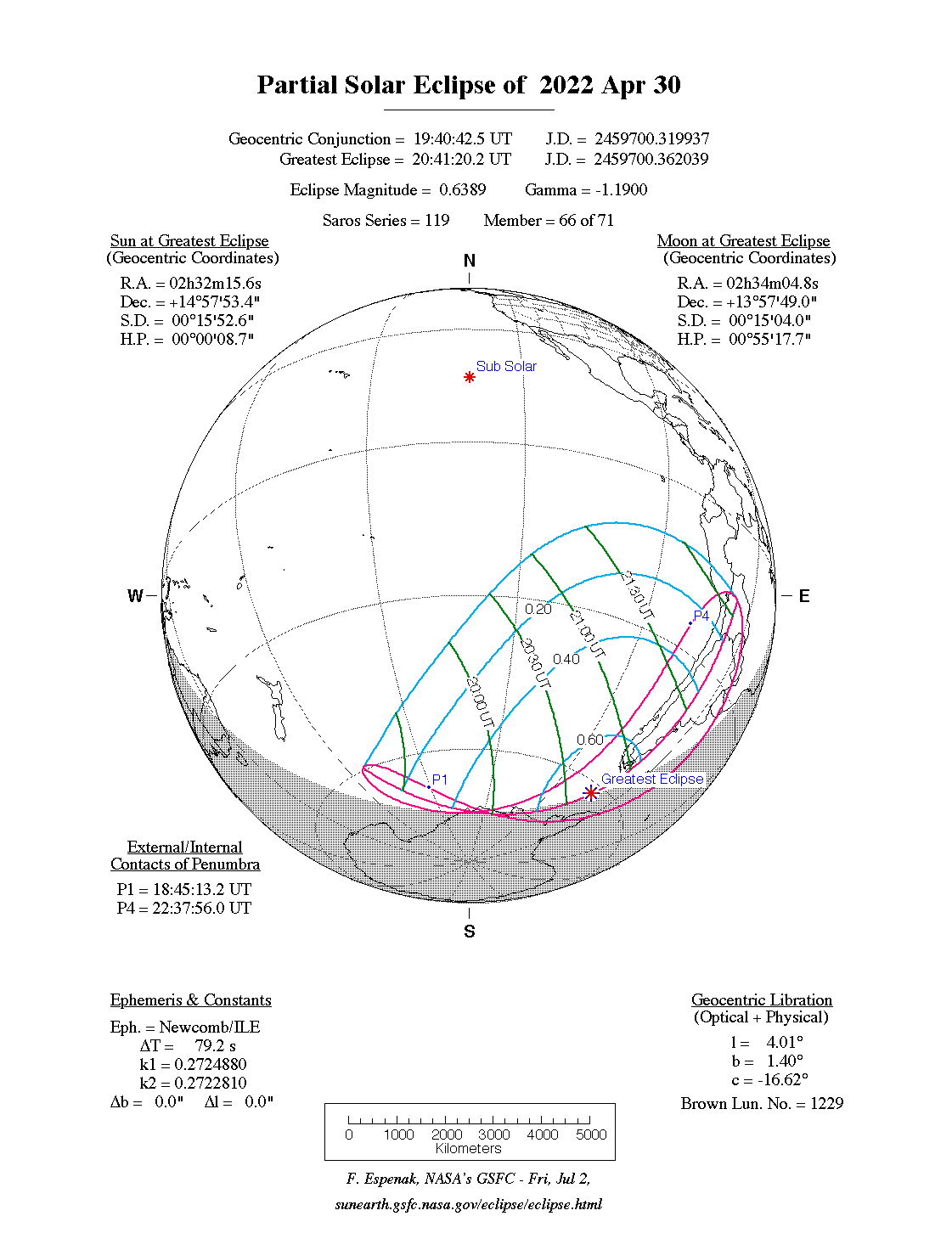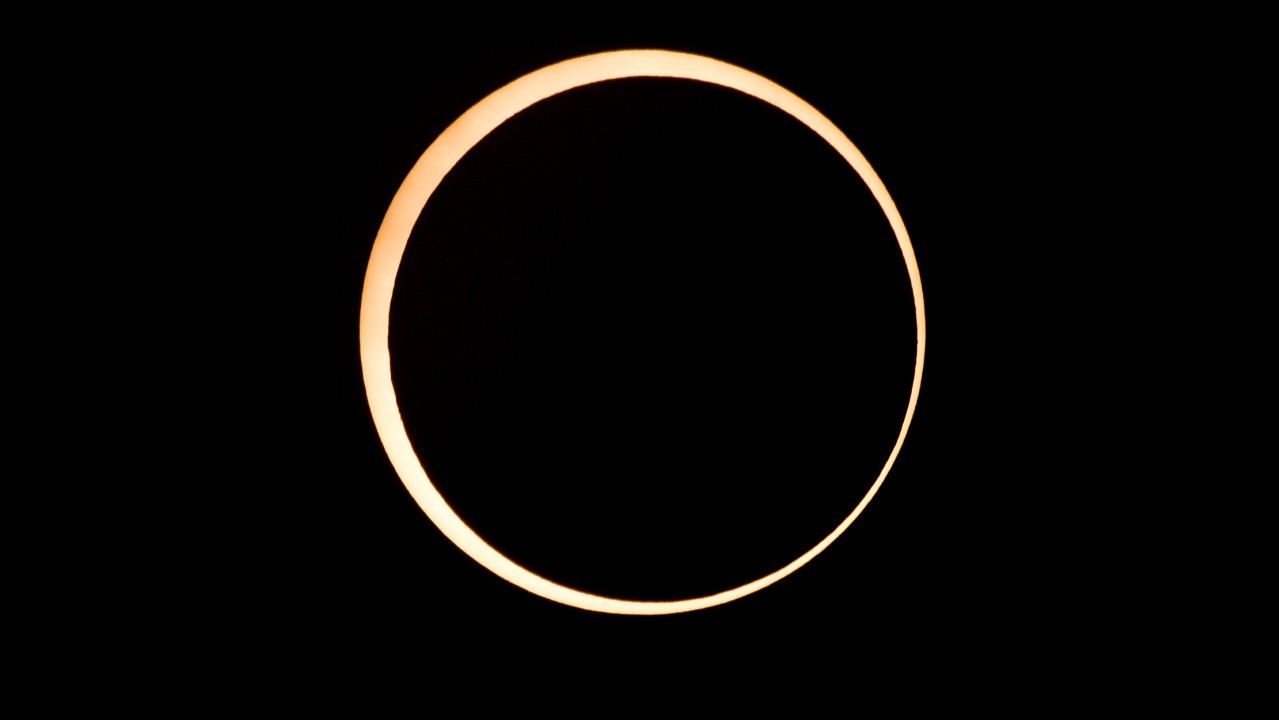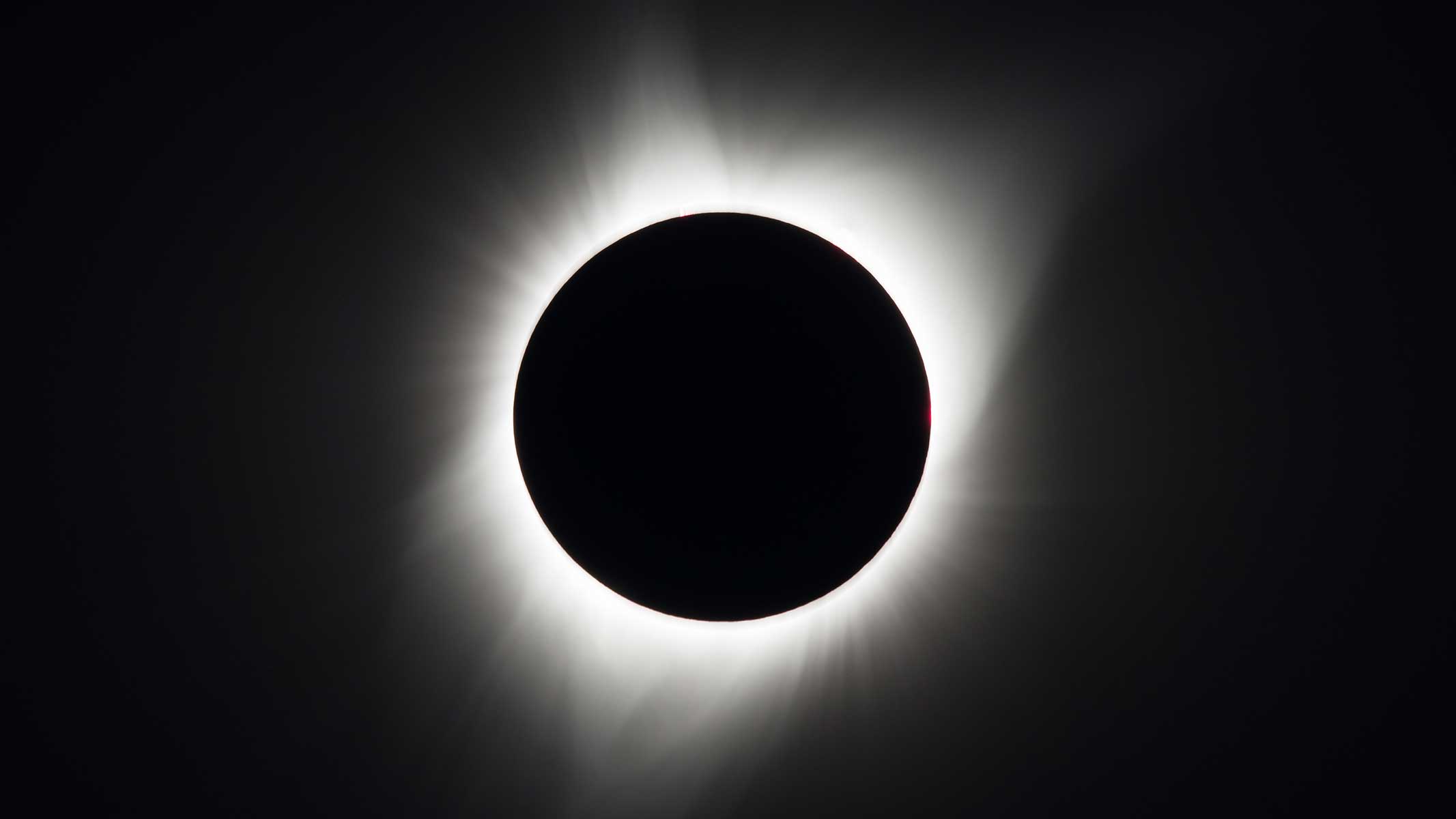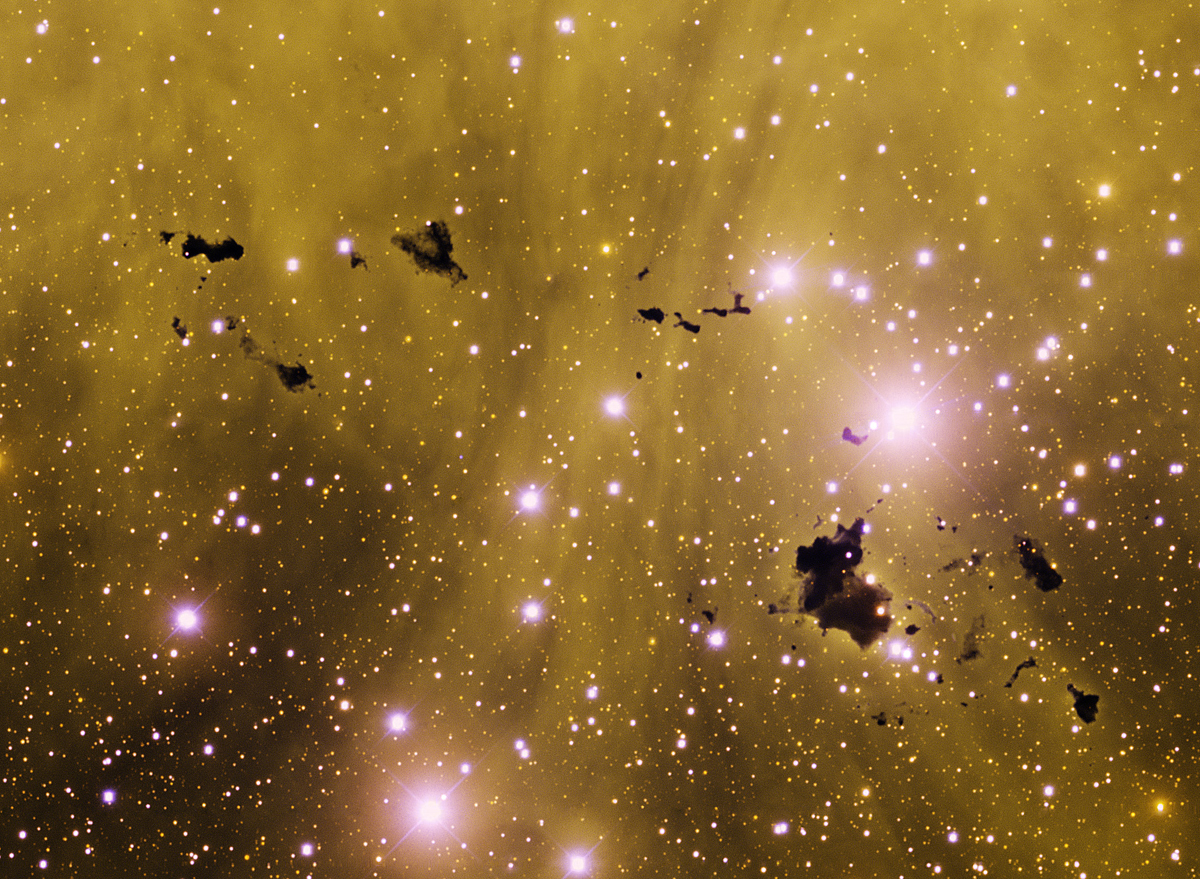Partial solar eclipse of April 2022: When and where it is and how to watch it online
It will be visible across parts of Antarctica, the southern tip of South America, and the Pacific and Atlantic oceans.
Update for 6:14 pm ET: TimeandDate.com's webcast for the partial solar eclipse of April 30, 2022 from Chile and Argentina has ended as the sun has set during mid-eclipse. Check out the amazing views from the video above. Read our full wrap story on the solar eclipse.
The first solar eclipse of 2022 is coming on April 30. There will be a narrow band of visibility across parts of Antarctica, the southern tip of South America, and the Pacific and Atlantic oceans. Or, you can watch it online.
Solar eclipses happen when the new moon passes in front of the face of the sun from Earth's perspective. (Never look at the sun directly with your eyes; instead, follow the safety guide later in this article to help you.)
Partial solar eclipses occur when the moon blocks only a portion of the solar disk. In this case, roughly 64% of the sun's disk will be blotted out at most, according to NASA. The amount will vary depending on your viewing location.
Related: Amazing solar eclipse pictures from around the world
There will be no total solar eclipses in 2022. However, another partial solar eclipse, on Oct. 25, will be visible from Europe, Northeast Africa, the Middle East and West Asia, according to NASA.
The next solar eclipse will be on April 20, 2023; this eclipse will be a hybrid eclipse, displaying characteristics of both a total solar eclipse and a "ring of fire" or annular solar eclipse. The next total solar eclipse visible from North America will be on April 8, 2024; totality will be visible from Mexico, the central United States and eastern Canada.
Breaking space news, the latest updates on rocket launches, skywatching events and more!
Here are some tips to help you get the most out of the April 30 partial eclipse.
When is the solar eclipse and how to watch online
Partial eclipses last a bit longer than total solar eclipses. In total eclipses, we are subject to the moon's very small shadow, which can briefly cover the entire face of the sun. Partial phases, however, last a lot longer.
While the visibility of the eclipse depends on your region, timeanddate.com has information about when the eclipse begins and ends globally. The eclipse will first be visible at 2:45 p.m. EDT (1845 GMT). The maximum eclipse will happen a couple of hours later, at 4:41 p.m. EDT (2041 GMT). Then, the eclipse will end at 6:37 p.m. EDT (2237 GMT).
There will be some livestreams of the event if you, like most skywatchers, can't catch it in person. Timeanddate.com will have a webcast available on YouTube and has a live blog leading up to to the event. The webcast will begin at 3:30 p.m. EDT (1930 GMT) and show live views of the solar eclipse from Chile and Argentina ahead of peak eclipse.
Also, the India-based YouTube channel Gyaan ki gareebi Live will begin broadcasting at 1:45 p.m. EDT (1745 GMT) to offer live views from Chile.
The livestream is expected to last about five hours or so, providing coverage throughout the eclipse.
What will the partial solar eclipse look like?
A partial solar eclipse often looks like the moon has "bitten" or taken a piece out of the sun. You can imagine it very clearly when you think about solar system geometry: Because the moon is closer to Earth than the sun, it can pass in front of us.
The size of the "bite" you see depends on your location. The greatest magnitude will be approximately at the tip of South America and the surrounding ocean, according to timeanddate.com, so most landlubbers will need to make do with a rather smaller "bite."
When a total solar eclipse happens, that's due to a lucky coincidence. The sun's diameter is 400 times greater than the moon's, but the moon orbits 400 times closer to Earth than Earth orbits the sun. Roughly every 18 months, the paths coincide in such a way to allow a total solar eclipse.
Visibility maps for the partial solar eclipse
This particular solar eclipse will take place over largely unpopulated regions. It will include parts of Antarctica, the southern tip of South America, and the Pacific and Atlantic oceans; most of the viewing area will be over water.
Accordingly, there likely won't be many livestreams available for this event. Timeanddate.com will have a live blog (not a stream) available on this page. Also, the YouTube channel Gyaan ki gareebi Live will start a broadcast when the eclipse begins.
Solar eclipse viewing tips
WARNING: Looking directly at the sun can lead to blindness and other forms of permanent eye damage if you aren't wearing proper eye protection.
To safely observe the sun or watch an eclipse, you must use special protective eyewear or certified eclipse glasses. Basic sunglasses will not protect you, even if they have UV protection. In fact, the safest way to observe an eclipse is through indirect methods, using a pinhole camera that's easy to scrounge together with equipment at home.
If you want to use a camera, make sure to use special solar filters on your equipment. Your smartphone also needs protective filters, and if you use it, stick to a simple, wide-angle snap to protect the camera.
NASA advises extreme caution during solar eclipse viewings, emphasizing that it is safe to remove your glasses only during total phases of a total solar eclipse. For partial eclipses, keep the glasses on at all times. (For total eclipses, NASA has a guide for when to take off the glasses.)
What causes solar eclipses?
Solar eclipses occur when the moon passes in front of the sun. Because the moon perfectly covers the sun only when the geometry is just right, partial solar eclipses like this one are much more common.
The sun is roughly 400 times bigger than the moon, but the moon orbits Earth roughly 400 times closer than Earth orbits the sun. At times, the moon is close enough and in just the right position to completely cover the sun from Earth's perspective for up to 7.5 minutes. However, that situation happens only every 18 months. Partial eclipses happen much more often.
Eclipses happen when the moon is in its new phase, but because of its 5-degree tilt relative to Earth's orbit around the sun, you won't see an eclipse every new moon. But at least twice each year (sometimes as many as five times in a year), a new moon can align itself in just such a way to eclipse the sun.
The alignments repeat in a pattern known as a Saros cycle. Ultimately, how an eclipse happens comes down to the moon's distance from Earth and, to a lesser degree, Earth's distance from the sun.
When is the next solar eclipse?
The next solar eclipse, after the partial solar eclipse on April 30, is a partial one on Oct. 25, according to NASA. It will be visible in Europe, Northeast Africa, the Middle East and Asia.
Then, in 2023, there will be two solar eclipses. On April 20, we can expect a hybrid eclipse. This special type of eclipse occurs when the moon's distance is near its limit for the umbra — the part of the moon's shadow where the whole sun is blocked by the moon — to reach Earth. Only some regions will experience totality with this eclipse. The hybrid eclipse will be visible in Indonesia, some of Australia and Papua New Guinea, and the eclipse will be visible in other forms in Southeast Asia, the East Indies, other parts of Australia, the Philippines and New Zealand.
The second eclipse of 2023 will be on Oct. 14 and will be visible from North America, Central America and South America. It will be an annular eclipse, meaning the sun forms a "ring of fire" around the sun. The annular phase will be best visible in the western United States, Central America, Colombia and Brazil.
We will finally see a total solar eclipse on April 8, 2024, in North America and Central America. The total phase will be visible from Mexico, the central United States and eastern Canada.
Another eclipse in 2024, an annular one, will take place on Oct. 2. It will be visible in the Pacific and southern parts of South America, with the annular phase best visible in southern Chile and southern Argentina.
This story, originally posted on April 22, was updated on April 29 with new details about solar eclipse livestreams.
Editor's Note: If you snap an amazing solar eclipse photo and would like to share it with Space.com's readers, send your photo(s), comments, and your name and location to spacephotos@space.com.
Follow Elizabeth Howell on Twitter @howellspace. Follow us on Twitter @Spacedotcom and on Facebook.

Elizabeth Howell (she/her), Ph.D., was a staff writer in the spaceflight channel between 2022 and 2024 specializing in Canadian space news. She was contributing writer for Space.com for 10 years from 2012 to 2024. Elizabeth's reporting includes multiple exclusives with the White House, leading world coverage about a lost-and-found space tomato on the International Space Station, witnessing five human spaceflight launches on two continents, flying parabolic, working inside a spacesuit, and participating in a simulated Mars mission. Her latest book, "Why Am I Taller?" (ECW Press, 2022) is co-written with astronaut Dave Williams.






